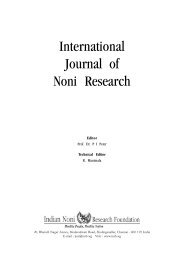International Journal of Noni Research - Noni Family
International Journal of Noni Research - Noni Family
International Journal of Noni Research - Noni Family
Create successful ePaper yourself
Turn your PDF publications into a flip-book with our unique Google optimized e-Paper software.
77 Intl. J. <strong>Noni</strong> Res. 2007, 2(1-2)<br />
D.R.Singh et al. Peptide and Mineral pr<strong>of</strong>ile <strong>of</strong> Morinda citrifolia fruits and leaves<br />
vegetation depend on physical and chemical property <strong>of</strong> soil, soil erosion,<br />
cropping pattern, fertilizer/chemical application, species and genetic difference<br />
<strong>of</strong> plant, stage <strong>of</strong> maturity, presence <strong>of</strong> other mineral, etc. (McDowell et al.,<br />
1993). Studies on soil-plant relationship in respect <strong>of</strong> minerals are important<br />
and to understand the mineral uptake and the contents <strong>of</strong> the fruits and leaves<br />
the soil from the respective areas were also collected for micro and macro<br />
mineral analysis.<br />
Materials & Methods<br />
An extensive survey was made in South Andaman and as per the location <strong>of</strong> the<br />
tree various accessions were given and soil samples were collected by using<br />
maun cover (7 cm & 60 cm length) auger. The soil samples were air dried,<br />
powdered with wooden mallet and sieved through a 2 mm sieve. The sieved<br />
samples ( < 2 mm) were analyzed for potassium ( K), sodium ( Na), calcium<br />
( Ca), magnesium ( Mg), iron ( Fe), copper ( Cu), manganese (Mn) and zinc<br />
( Zn) content as suggested by Page et al., ( 1982).<br />
The fruit qualitative parameters were determined by the method as described<br />
by Ranganna (1986). The TSS <strong>of</strong> the samples was estimated by hand<br />
refractometer. The fruit size and general appearance were estimated by<br />
metroglyph method and mature fruits <strong>of</strong> different accessions were washed and<br />
pulp was taken out with the help <strong>of</strong> knife and dried in an air circulatory tray<br />
drier at 60 0 C for 48 h. Dried pieces were cooled and powdered in a heavy duty<br />
grinder. For analysis, the powder was sieved using a 60 mesh sieve and packed<br />
in 200 gauge high density polythene bags (Chavan et al., 1995). The quantitative<br />
estimation <strong>of</strong> minerals in fruits and leaves were carried out by using an atomic<br />
absorption spectrophotometer. The dry ashing method was followed for<br />
estimation <strong>of</strong> micro and macro minerals immature dried leaves (Jones et al.,<br />
1969).<br />
Peptide pr<strong>of</strong>ile by HPLC : Raw juice extracted from M. citrifolia fruits and leaves<br />
were prepared for estimation <strong>of</strong> the peptide pr<strong>of</strong>ile. The peptide pr<strong>of</strong>ile <strong>of</strong> the<br />
Morinda citrifoilia fruits and leaves water extract were studied by using high<br />
performance liquid chromatography (HPLC). The water extract <strong>of</strong> M.citrifolia<br />
fruits and leaves were prepared and filtered through 0.45 u membrane filter.<br />
The extract was run through HPLC column C-18 with mobile phase water and<br />
acetonitrinle in 0.1% trifluoroacetic acid (TFA) in gradient condition. The flow<br />
rate <strong>of</strong> the column was adjusted at 1 ml/min. The standard peptide mixtures<br />
were run through the column. The eluent A <strong>of</strong> mobile phase was a 0.1% by<br />
weight aqueous solution <strong>of</strong> trifluoroacetic acid (TFA) and eluent B was<br />
acetonitrile containing 0.1% by weight TFA. A fifty minute linear gradient from<br />
0 to 30% B was run at a flow rate <strong>of</strong> 1 ml/min.








